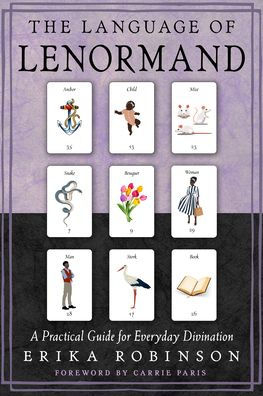Many people work with the Tarot when they are seeking a way to understand more about the world both within and without. It is, however, a complex system that can feel daunting to newcomers -- so much to understand! all at once! The Lenormand deck was created as a simpler, more accessible, approach to unveiling hidden truths.
Before reading Erika Robinson's The Language of Lenormand, I had zero experience with this method of divination. (Confession, I am a long time tarot reader, who doesn't work with oracle decks at all. So I wasn't even particularly interested.) But, like Robinson, I love reading -- that delicious alchemical transformation of flat symbols into information that changes minds and realities. Moreover, Robinson does an exquisite job of creating an oracle that moves beyond rules and strictures into a place of empowerment and creativity.
For newcomers (as was I), Lenormand is a divination system typically made up of thirty-six picture cards. Strung together in myriad combinations, the pictures become sentences, then paragraphs, then story. Unlike Tarot, where a reading can be given with a single card, Lenormand is meant to function in groups of three or more cards together.
Robinson teaches us the cards in groups of three, underscoring the need for collectivity at the outset. Chapter One is Rider (1) / Clover (2) / Ship (3); Chapter Two is House (4) / Tree (5) / Clouds (6); and Chapter Three is Snake (7) / Coffin (8) / Bouquet (9). We then pause in Chapter Four to discuss the value of the Significator and how it functions in Lenormand. In Chapter Five we resume our journey through the cards with Scythe (10) / Whip (11) / Birds (12) and Chapter Six has us working with five and seven card spreads. Chapter Seven looks at Child (13) / Fox (14) / Bear (15), Chapter 8 at Stars (16) / Stork (17) / Dog (18), and we end up in Chapter Nine with the Nine Box Spread, the traditionally foundational spread for the big reading of all 36 cards. The last Chapters look at Tower (19) / Garden (20) / Mountain (21), Crossroads (22) / Mice (23) / Heart (24), Ring (25) / Book (26) / Letter (27), Man (28) / Woman (29) / Lily (30), Sun (31) / Moon (32) / Key (33), Fish (34) / Anchor (35) / Cross (36).
All throughout, Robinson's joy in language shines. Stuffed with brief quotes that illuminate her points, Robinson gives us a giant tool box to work with this interesting and versatile oracle.
As a complete beginner, I now feel I could work with this oracle and discover new sources of information to enrich myself and my practices.
~review by Lisa McSherry
Author: Erika Robinson
Weiser Books, 2023
pp. 190, $18.95

